Taxation Law Application Scenarios
VerifiedAdded on 2020/04/07
|10
|1292
|44
AI Summary
This assignment focuses on applying Australian taxation law principles to practical scenarios. It involves calculating the foreign tax offset for Angelo, who paid taxes to foreign authorities, and determining the net taxable income for a partnership firm by analyzing assessable income, deductible expenses, and outgoings. The solution provides step-by-step calculations and references relevant tax laws and guidelines.
Contribute Materials
Your contribution can guide someone’s learning journey. Share your
documents today.
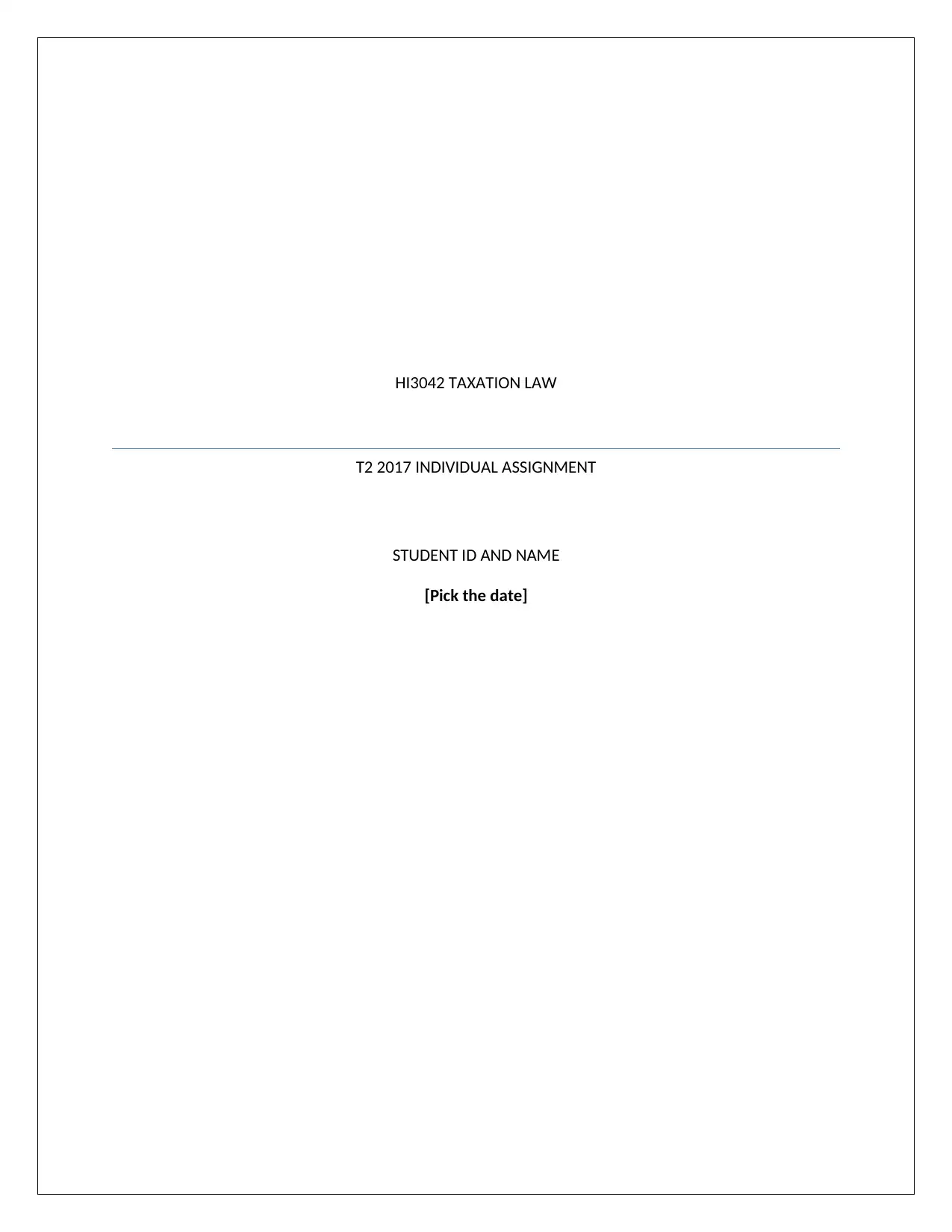
HI3042 TAXATION LAW
T2 2017 INDIVIDUAL ASSIGNMENT
STUDENT ID AND NAME
[Pick the date]
T2 2017 INDIVIDUAL ASSIGNMENT
STUDENT ID AND NAME
[Pick the date]
Secure Best Marks with AI Grader
Need help grading? Try our AI Grader for instant feedback on your assignments.
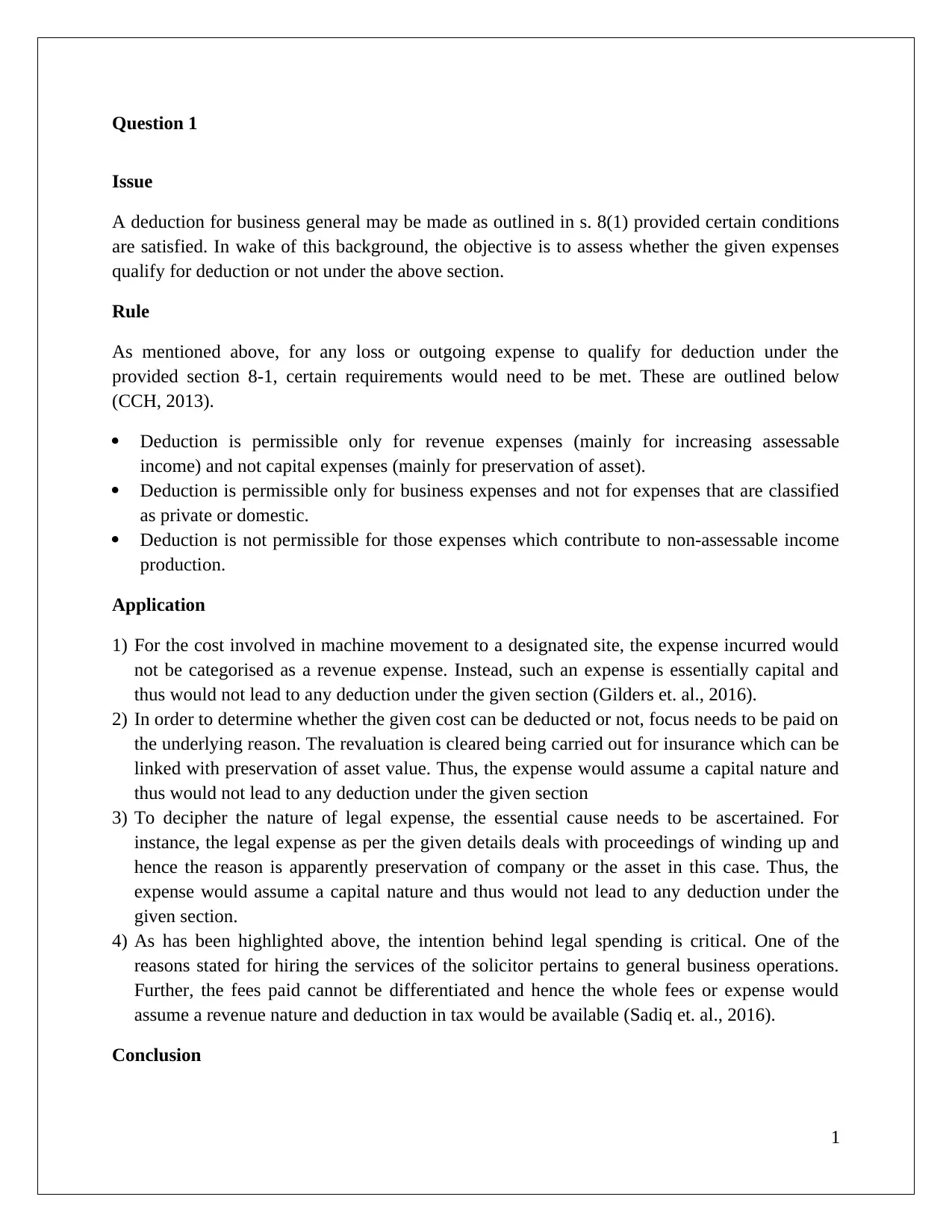
Question 1
Issue
A deduction for business general may be made as outlined in s. 8(1) provided certain conditions
are satisfied. In wake of this background, the objective is to assess whether the given expenses
qualify for deduction or not under the above section.
Rule
As mentioned above, for any loss or outgoing expense to qualify for deduction under the
provided section 8-1, certain requirements would need to be met. These are outlined below
(CCH, 2013).
Deduction is permissible only for revenue expenses (mainly for increasing assessable
income) and not capital expenses (mainly for preservation of asset).
Deduction is permissible only for business expenses and not for expenses that are classified
as private or domestic.
Deduction is not permissible for those expenses which contribute to non-assessable income
production.
Application
1) For the cost involved in machine movement to a designated site, the expense incurred would
not be categorised as a revenue expense. Instead, such an expense is essentially capital and
thus would not lead to any deduction under the given section (Gilders et. al., 2016).
2) In order to determine whether the given cost can be deducted or not, focus needs to be paid on
the underlying reason. The revaluation is cleared being carried out for insurance which can be
linked with preservation of asset value. Thus, the expense would assume a capital nature and
thus would not lead to any deduction under the given section
3) To decipher the nature of legal expense, the essential cause needs to be ascertained. For
instance, the legal expense as per the given details deals with proceedings of winding up and
hence the reason is apparently preservation of company or the asset in this case. Thus, the
expense would assume a capital nature and thus would not lead to any deduction under the
given section.
4) As has been highlighted above, the intention behind legal spending is critical. One of the
reasons stated for hiring the services of the solicitor pertains to general business operations.
Further, the fees paid cannot be differentiated and hence the whole fees or expense would
assume a revenue nature and deduction in tax would be available (Sadiq et. al., 2016).
Conclusion
1
Issue
A deduction for business general may be made as outlined in s. 8(1) provided certain conditions
are satisfied. In wake of this background, the objective is to assess whether the given expenses
qualify for deduction or not under the above section.
Rule
As mentioned above, for any loss or outgoing expense to qualify for deduction under the
provided section 8-1, certain requirements would need to be met. These are outlined below
(CCH, 2013).
Deduction is permissible only for revenue expenses (mainly for increasing assessable
income) and not capital expenses (mainly for preservation of asset).
Deduction is permissible only for business expenses and not for expenses that are classified
as private or domestic.
Deduction is not permissible for those expenses which contribute to non-assessable income
production.
Application
1) For the cost involved in machine movement to a designated site, the expense incurred would
not be categorised as a revenue expense. Instead, such an expense is essentially capital and
thus would not lead to any deduction under the given section (Gilders et. al., 2016).
2) In order to determine whether the given cost can be deducted or not, focus needs to be paid on
the underlying reason. The revaluation is cleared being carried out for insurance which can be
linked with preservation of asset value. Thus, the expense would assume a capital nature and
thus would not lead to any deduction under the given section
3) To decipher the nature of legal expense, the essential cause needs to be ascertained. For
instance, the legal expense as per the given details deals with proceedings of winding up and
hence the reason is apparently preservation of company or the asset in this case. Thus, the
expense would assume a capital nature and thus would not lead to any deduction under the
given section.
4) As has been highlighted above, the intention behind legal spending is critical. One of the
reasons stated for hiring the services of the solicitor pertains to general business operations.
Further, the fees paid cannot be differentiated and hence the whole fees or expense would
assume a revenue nature and deduction in tax would be available (Sadiq et. al., 2016).
Conclusion
1
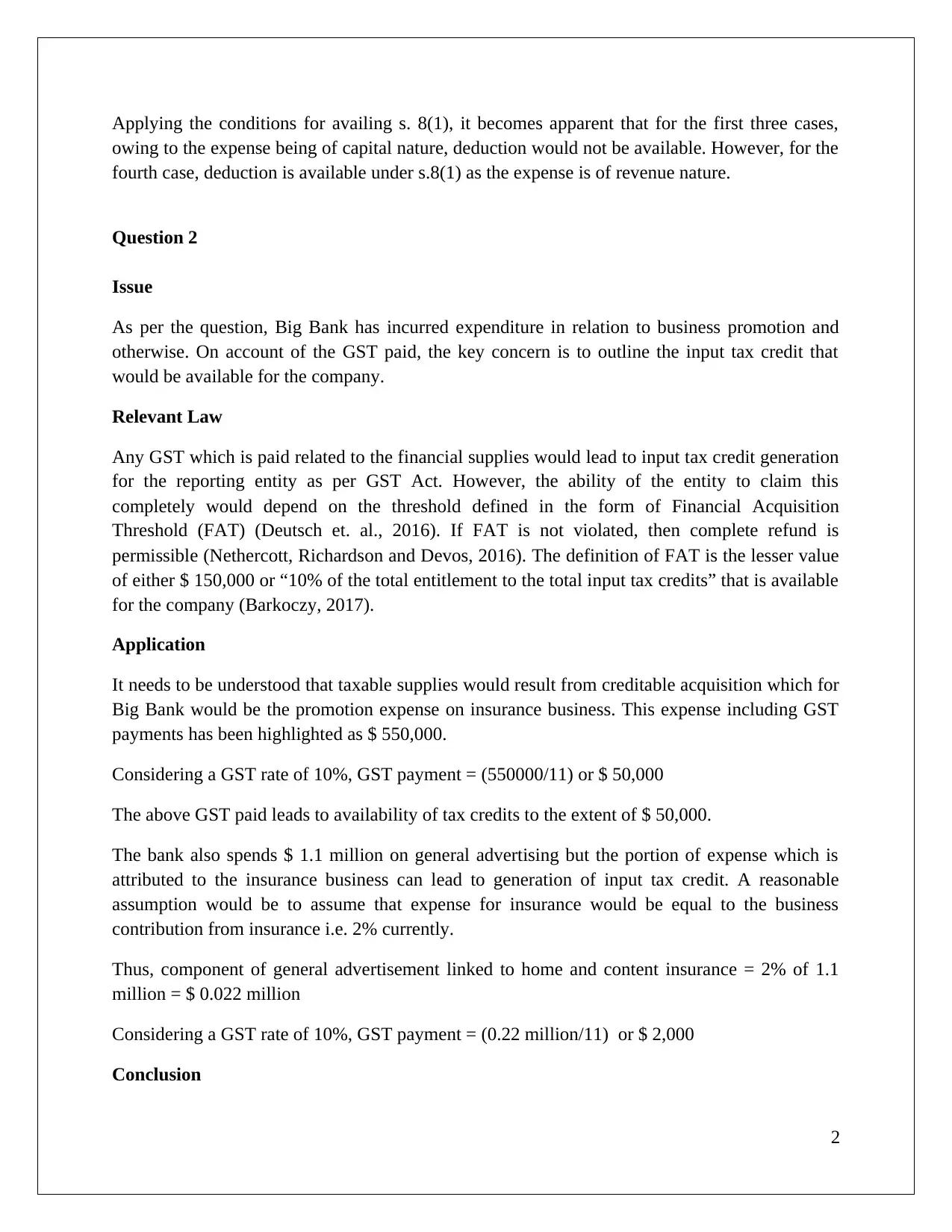
Applying the conditions for availing s. 8(1), it becomes apparent that for the first three cases,
owing to the expense being of capital nature, deduction would not be available. However, for the
fourth case, deduction is available under s.8(1) as the expense is of revenue nature.
Question 2
Issue
As per the question, Big Bank has incurred expenditure in relation to business promotion and
otherwise. On account of the GST paid, the key concern is to outline the input tax credit that
would be available for the company.
Relevant Law
Any GST which is paid related to the financial supplies would lead to input tax credit generation
for the reporting entity as per GST Act. However, the ability of the entity to claim this
completely would depend on the threshold defined in the form of Financial Acquisition
Threshold (FAT) (Deutsch et. al., 2016). If FAT is not violated, then complete refund is
permissible (Nethercott, Richardson and Devos, 2016). The definition of FAT is the lesser value
of either $ 150,000 or “10% of the total entitlement to the total input tax credits” that is available
for the company (Barkoczy, 2017).
Application
It needs to be understood that taxable supplies would result from creditable acquisition which for
Big Bank would be the promotion expense on insurance business. This expense including GST
payments has been highlighted as $ 550,000.
Considering a GST rate of 10%, GST payment = (550000/11) or $ 50,000
The above GST paid leads to availability of tax credits to the extent of $ 50,000.
The bank also spends $ 1.1 million on general advertising but the portion of expense which is
attributed to the insurance business can lead to generation of input tax credit. A reasonable
assumption would be to assume that expense for insurance would be equal to the business
contribution from insurance i.e. 2% currently.
Thus, component of general advertisement linked to home and content insurance = 2% of 1.1
million = $ 0.022 million
Considering a GST rate of 10%, GST payment = (0.22 million/11) or $ 2,000
Conclusion
2
owing to the expense being of capital nature, deduction would not be available. However, for the
fourth case, deduction is available under s.8(1) as the expense is of revenue nature.
Question 2
Issue
As per the question, Big Bank has incurred expenditure in relation to business promotion and
otherwise. On account of the GST paid, the key concern is to outline the input tax credit that
would be available for the company.
Relevant Law
Any GST which is paid related to the financial supplies would lead to input tax credit generation
for the reporting entity as per GST Act. However, the ability of the entity to claim this
completely would depend on the threshold defined in the form of Financial Acquisition
Threshold (FAT) (Deutsch et. al., 2016). If FAT is not violated, then complete refund is
permissible (Nethercott, Richardson and Devos, 2016). The definition of FAT is the lesser value
of either $ 150,000 or “10% of the total entitlement to the total input tax credits” that is available
for the company (Barkoczy, 2017).
Application
It needs to be understood that taxable supplies would result from creditable acquisition which for
Big Bank would be the promotion expense on insurance business. This expense including GST
payments has been highlighted as $ 550,000.
Considering a GST rate of 10%, GST payment = (550000/11) or $ 50,000
The above GST paid leads to availability of tax credits to the extent of $ 50,000.
The bank also spends $ 1.1 million on general advertising but the portion of expense which is
attributed to the insurance business can lead to generation of input tax credit. A reasonable
assumption would be to assume that expense for insurance would be equal to the business
contribution from insurance i.e. 2% currently.
Thus, component of general advertisement linked to home and content insurance = 2% of 1.1
million = $ 0.022 million
Considering a GST rate of 10%, GST payment = (0.22 million/11) or $ 2,000
Conclusion
2
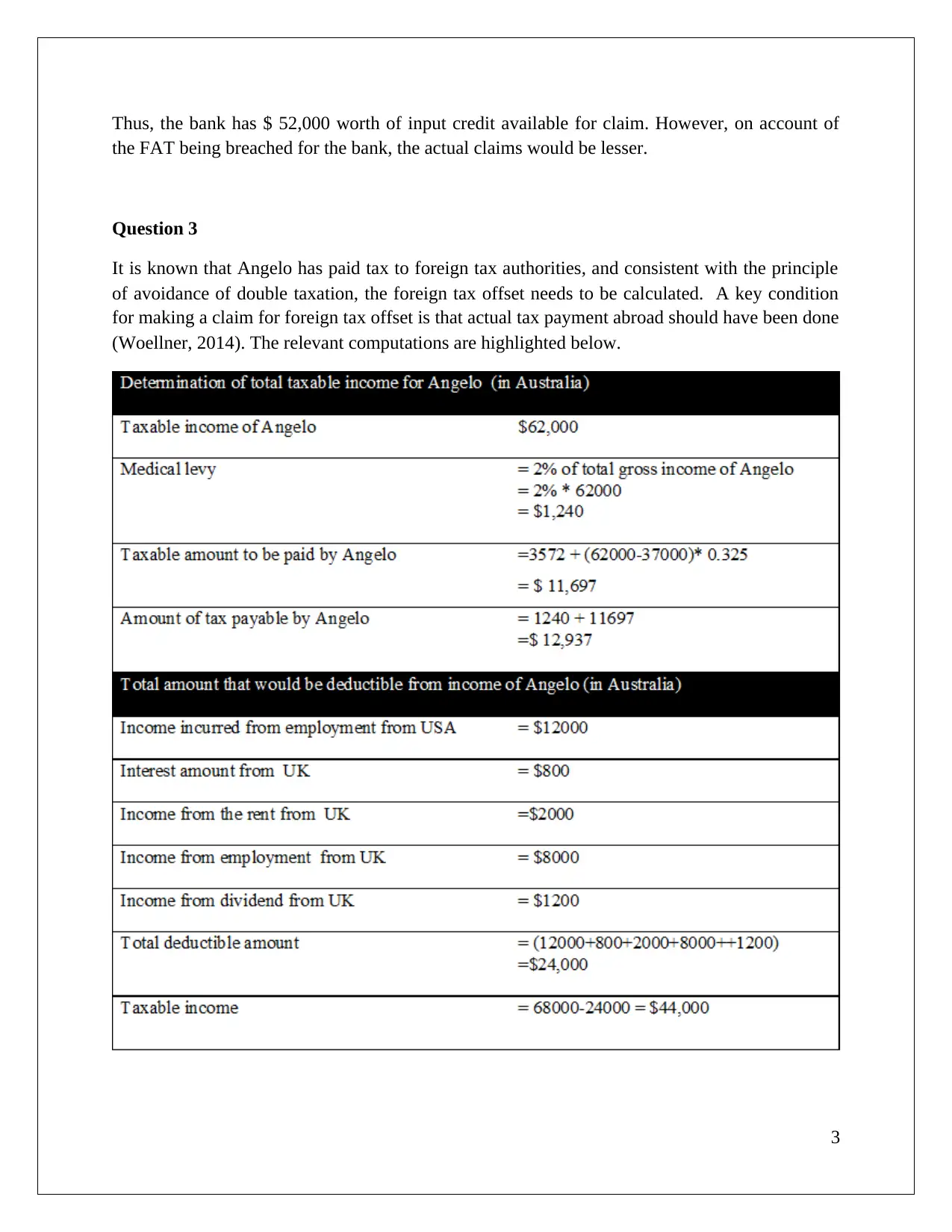
Thus, the bank has $ 52,000 worth of input credit available for claim. However, on account of
the FAT being breached for the bank, the actual claims would be lesser.
Question 3
It is known that Angelo has paid tax to foreign tax authorities, and consistent with the principle
of avoidance of double taxation, the foreign tax offset needs to be calculated. A key condition
for making a claim for foreign tax offset is that actual tax payment abroad should have been done
(Woellner, 2014). The relevant computations are highlighted below.
3
the FAT being breached for the bank, the actual claims would be lesser.
Question 3
It is known that Angelo has paid tax to foreign tax authorities, and consistent with the principle
of avoidance of double taxation, the foreign tax offset needs to be calculated. A key condition
for making a claim for foreign tax offset is that actual tax payment abroad should have been done
(Woellner, 2014). The relevant computations are highlighted below.
3
Secure Best Marks with AI Grader
Need help grading? Try our AI Grader for instant feedback on your assignments.
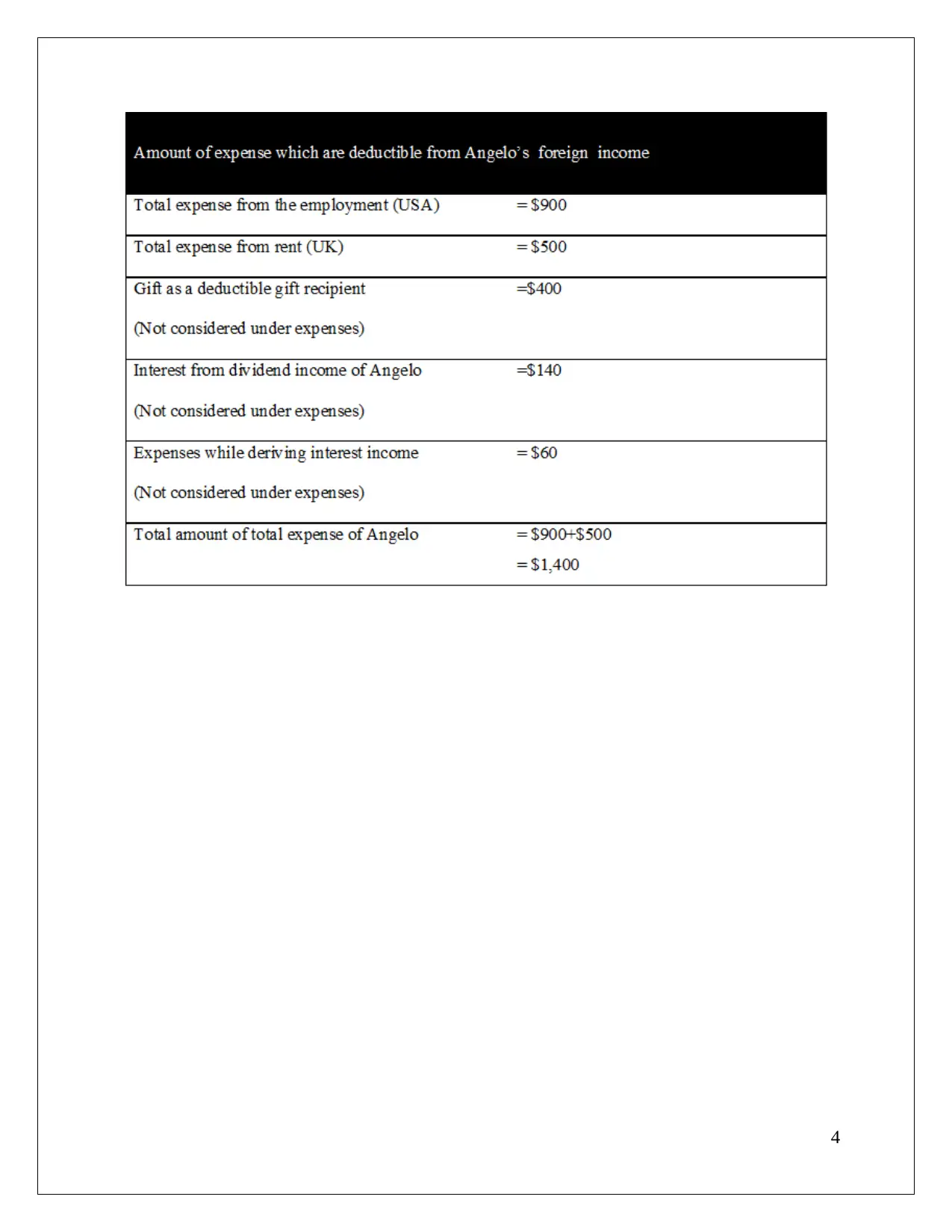
4
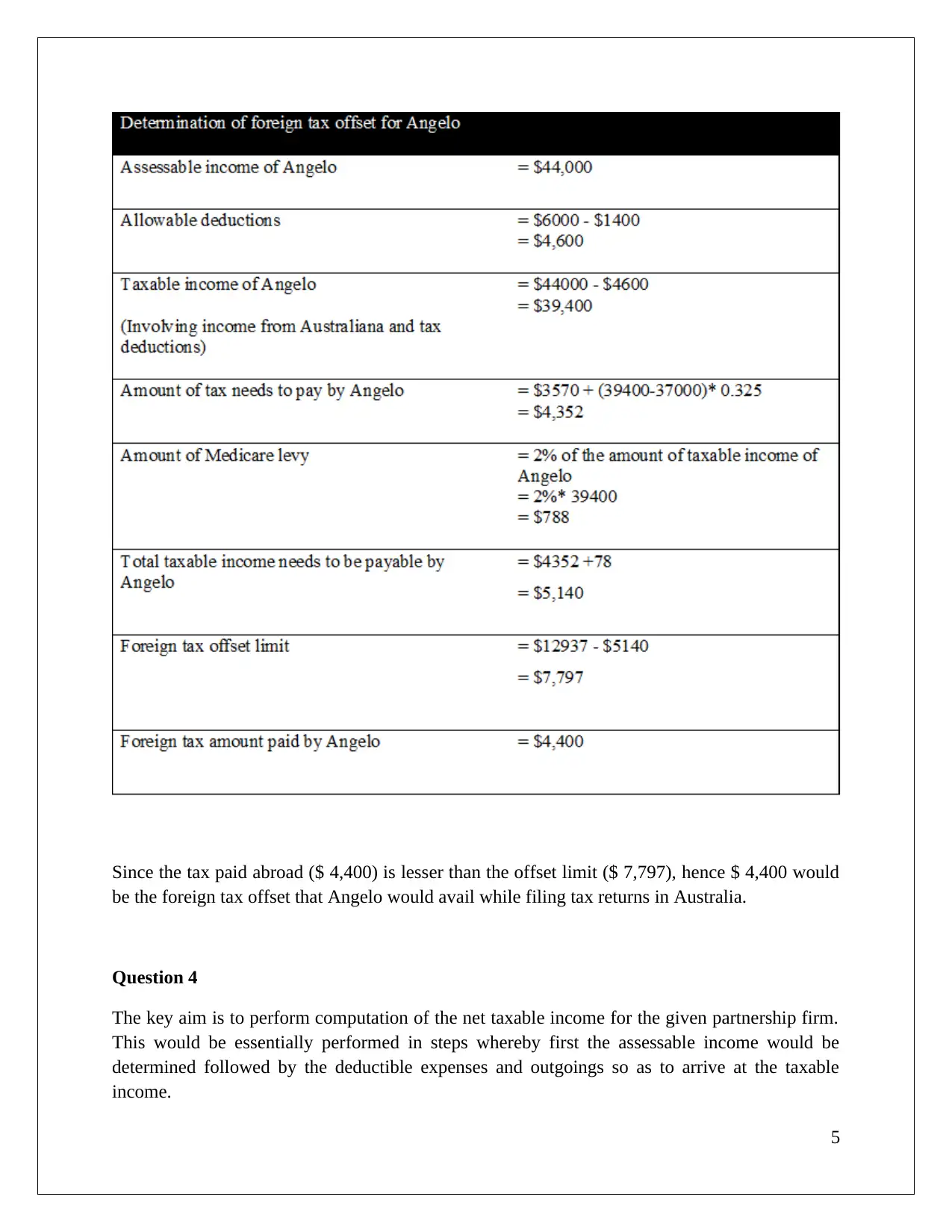
Since the tax paid abroad ($ 4,400) is lesser than the offset limit ($ 7,797), hence $ 4,400 would
be the foreign tax offset that Angelo would avail while filing tax returns in Australia.
Question 4
The key aim is to perform computation of the net taxable income for the given partnership firm.
This would be essentially performed in steps whereby first the assessable income would be
determined followed by the deductible expenses and outgoings so as to arrive at the taxable
income.
5
be the foreign tax offset that Angelo would avail while filing tax returns in Australia.
Question 4
The key aim is to perform computation of the net taxable income for the given partnership firm.
This would be essentially performed in steps whereby first the assessable income would be
determined followed by the deductible expenses and outgoings so as to arrive at the taxable
income.
5
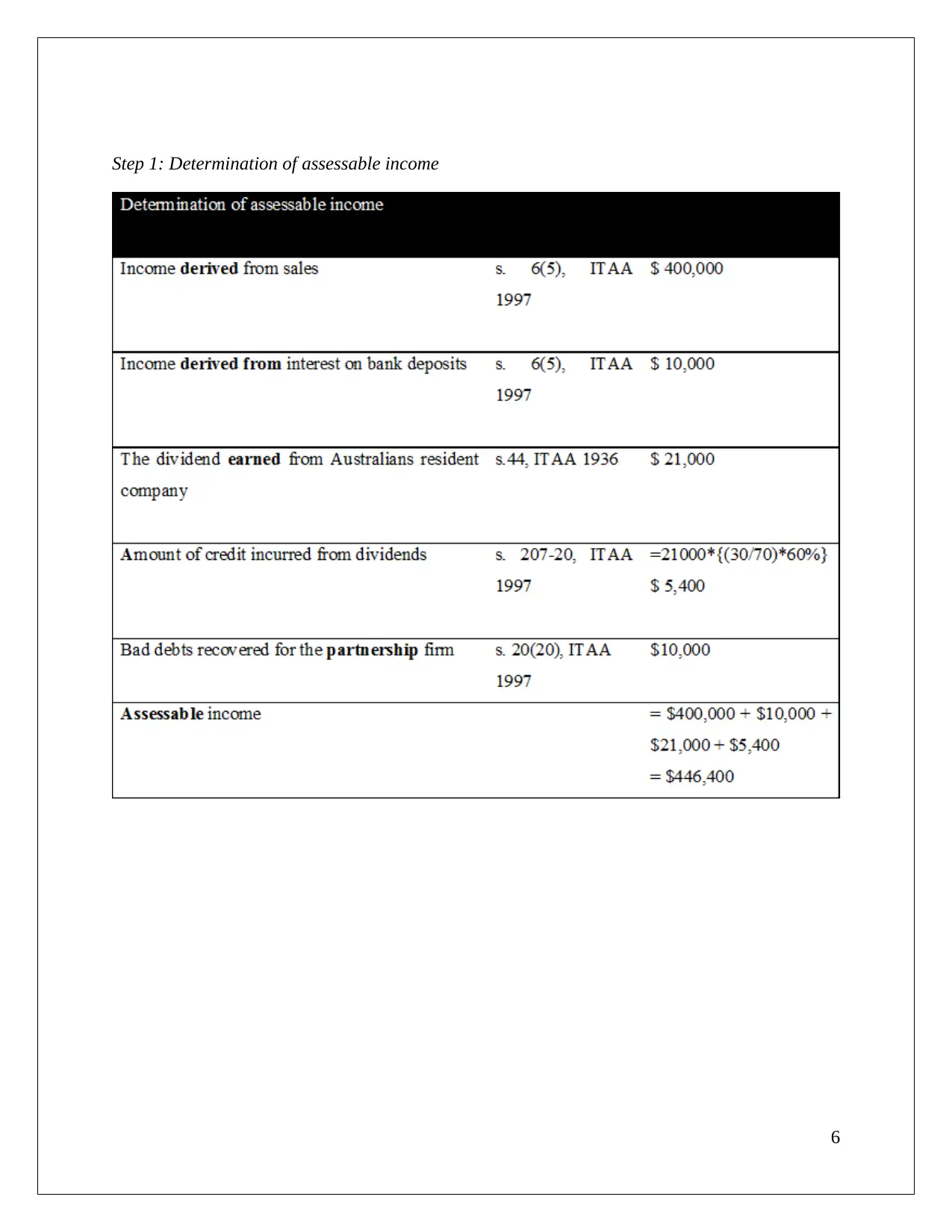
Step 1: Determination of assessable income
6
6
Paraphrase This Document
Need a fresh take? Get an instant paraphrase of this document with our AI Paraphraser
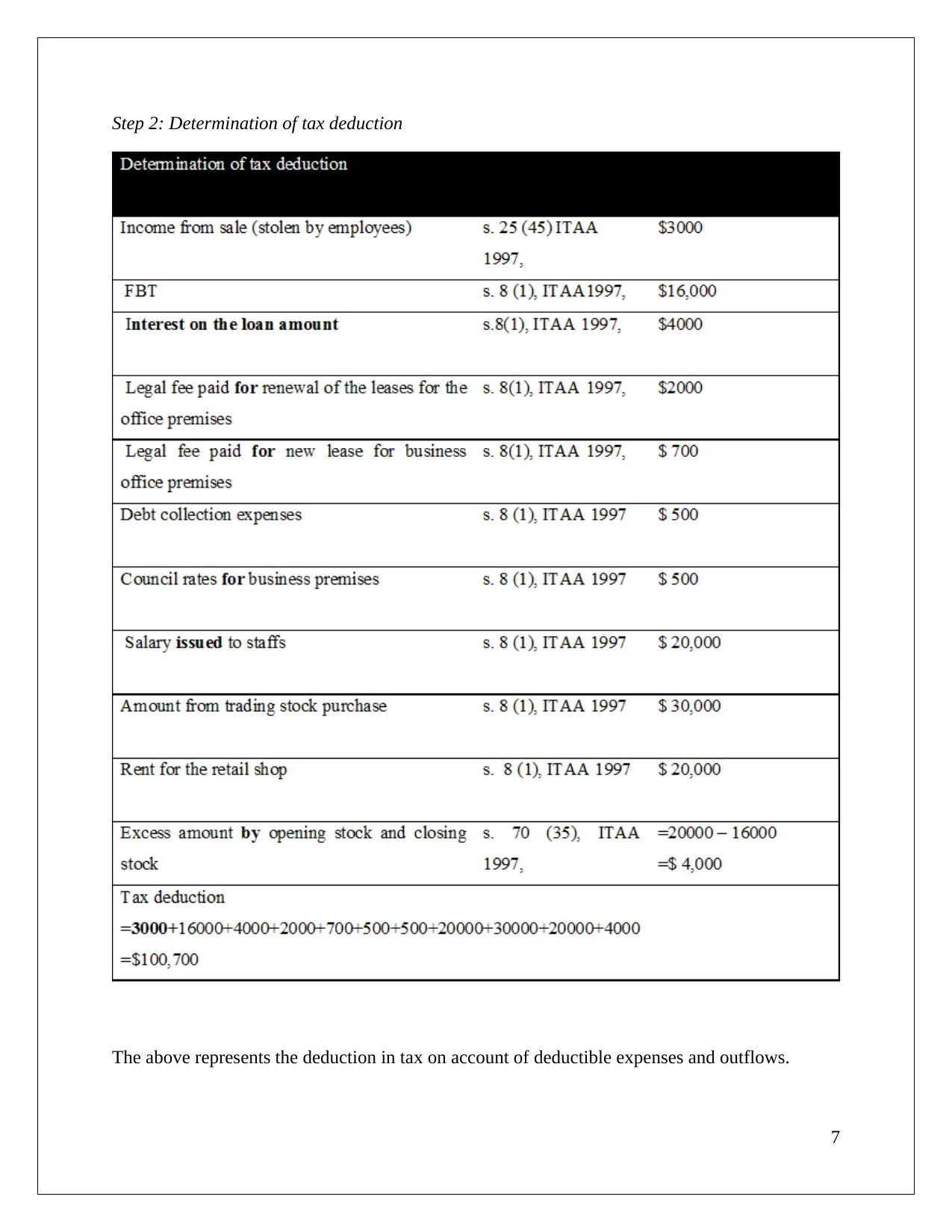
Step 2: Determination of tax deduction
The above represents the deduction in tax on account of deductible expenses and outflows.
7
The above represents the deduction in tax on account of deductible expenses and outflows.
7

Step 3: Determination of taxable income (For Partnership Firm).
Taxable income = Assessable income ($ 446, 400) – Deductions in tax on account of expenses
and outgoings ($100,700) = $ 345,700
8
Taxable income = Assessable income ($ 446, 400) – Deductions in tax on account of expenses
and outgoings ($100,700) = $ 345,700
8
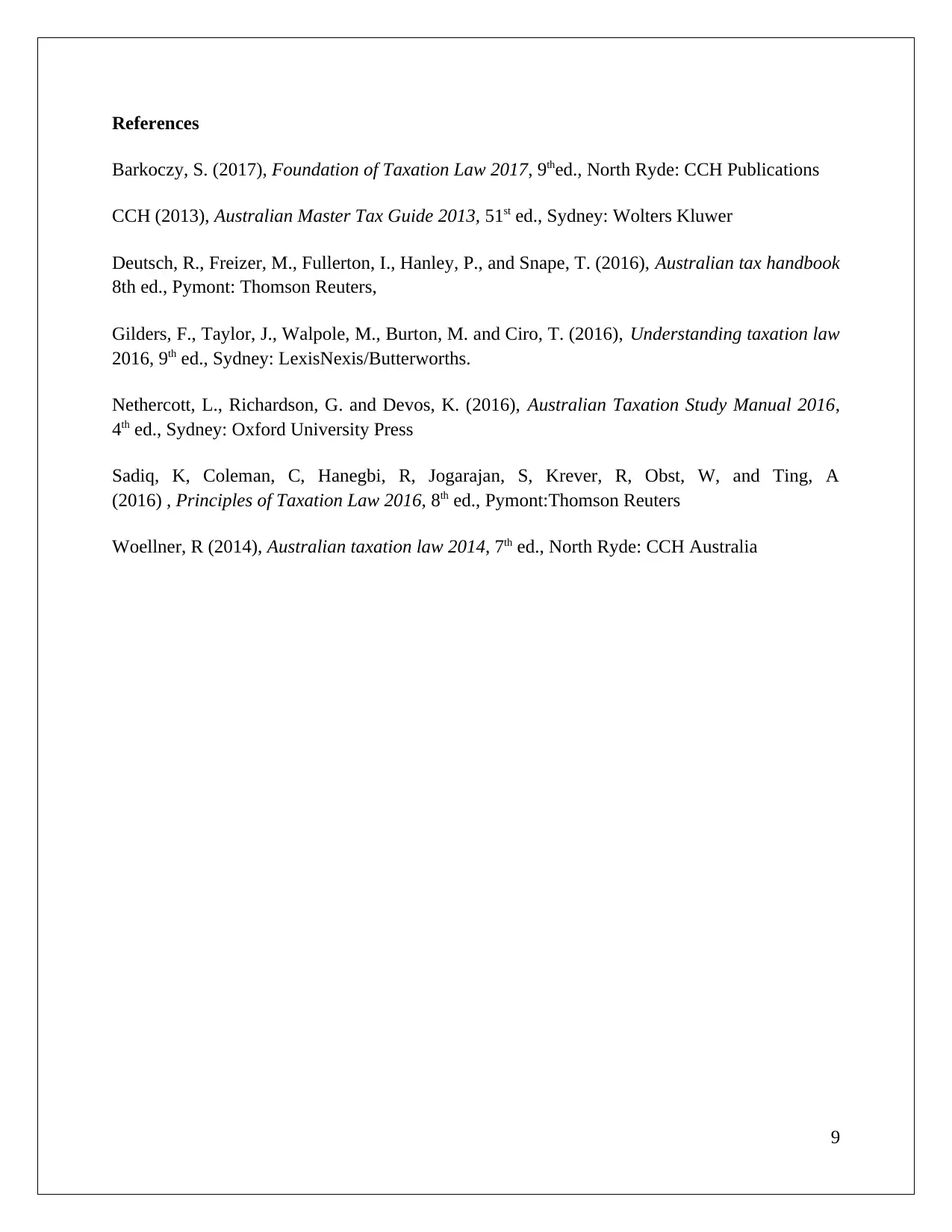
References
Barkoczy, S. (2017), Foundation of Taxation Law 2017, 9thed., North Ryde: CCH Publications
CCH (2013), Australian Master Tax Guide 2013, 51st ed., Sydney: Wolters Kluwer
Deutsch, R., Freizer, M., Fullerton, I., Hanley, P., and Snape, T. (2016), Australian tax handbook
8th ed., Pymont: Thomson Reuters,
Gilders, F., Taylor, J., Walpole, M., Burton, M. and Ciro, T. (2016), Understanding taxation law
2016, 9th ed., Sydney: LexisNexis/Butterworths.
Nethercott, L., Richardson, G. and Devos, K. (2016), Australian Taxation Study Manual 2016,
4th ed., Sydney: Oxford University Press
Sadiq, K, Coleman, C, Hanegbi, R, Jogarajan, S, Krever, R, Obst, W, and Ting, A
(2016) , Principles of Taxation Law 2016, 8th ed., Pymont:Thomson Reuters
Woellner, R (2014), Australian taxation law 2014, 7th ed., North Ryde: CCH Australia
9
Barkoczy, S. (2017), Foundation of Taxation Law 2017, 9thed., North Ryde: CCH Publications
CCH (2013), Australian Master Tax Guide 2013, 51st ed., Sydney: Wolters Kluwer
Deutsch, R., Freizer, M., Fullerton, I., Hanley, P., and Snape, T. (2016), Australian tax handbook
8th ed., Pymont: Thomson Reuters,
Gilders, F., Taylor, J., Walpole, M., Burton, M. and Ciro, T. (2016), Understanding taxation law
2016, 9th ed., Sydney: LexisNexis/Butterworths.
Nethercott, L., Richardson, G. and Devos, K. (2016), Australian Taxation Study Manual 2016,
4th ed., Sydney: Oxford University Press
Sadiq, K, Coleman, C, Hanegbi, R, Jogarajan, S, Krever, R, Obst, W, and Ting, A
(2016) , Principles of Taxation Law 2016, 8th ed., Pymont:Thomson Reuters
Woellner, R (2014), Australian taxation law 2014, 7th ed., North Ryde: CCH Australia
9
1 out of 10
Related Documents
Your All-in-One AI-Powered Toolkit for Academic Success.
+13062052269
info@desklib.com
Available 24*7 on WhatsApp / Email
![[object Object]](/_next/static/media/star-bottom.7253800d.svg)
Unlock your academic potential
© 2024 | Zucol Services PVT LTD | All rights reserved.





